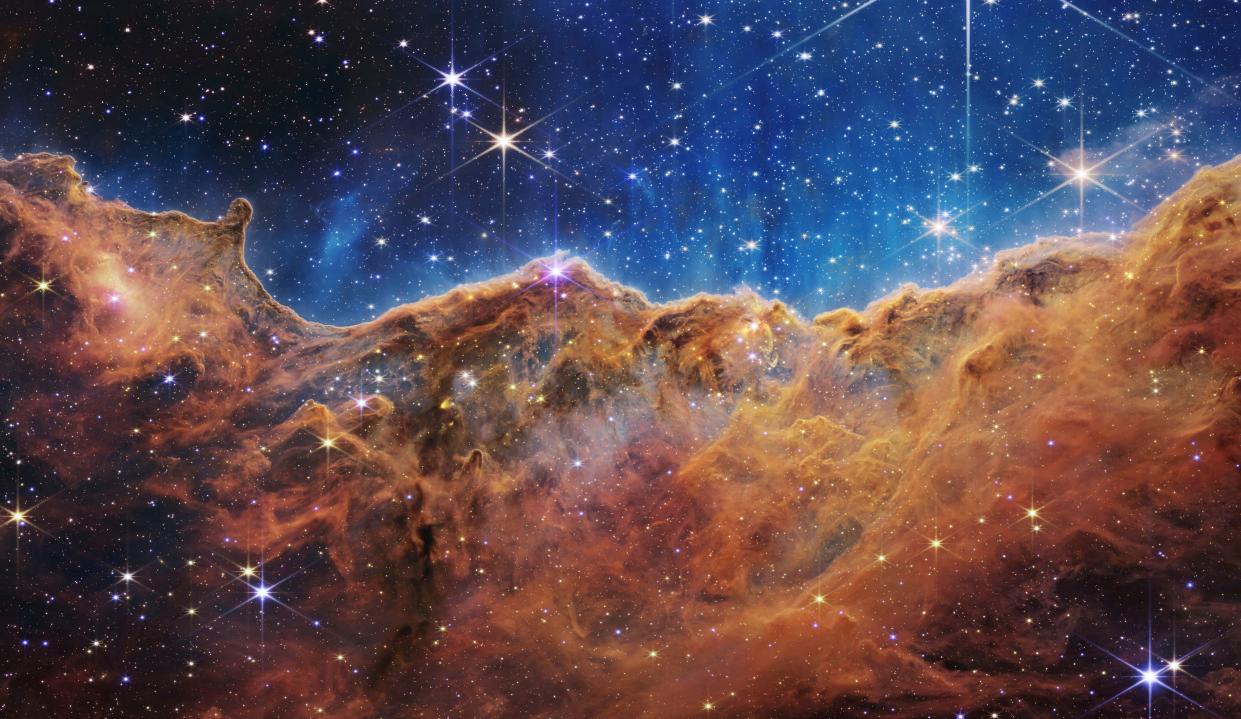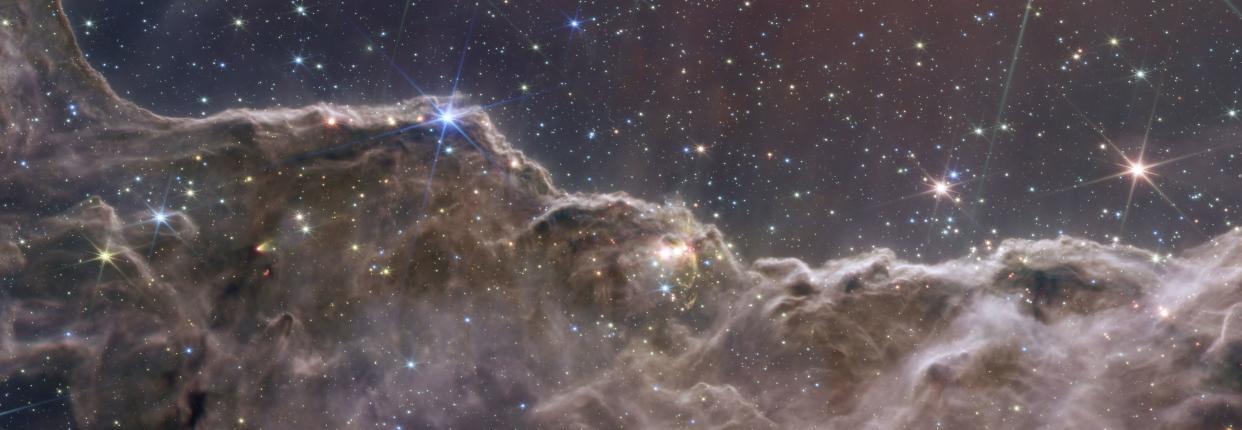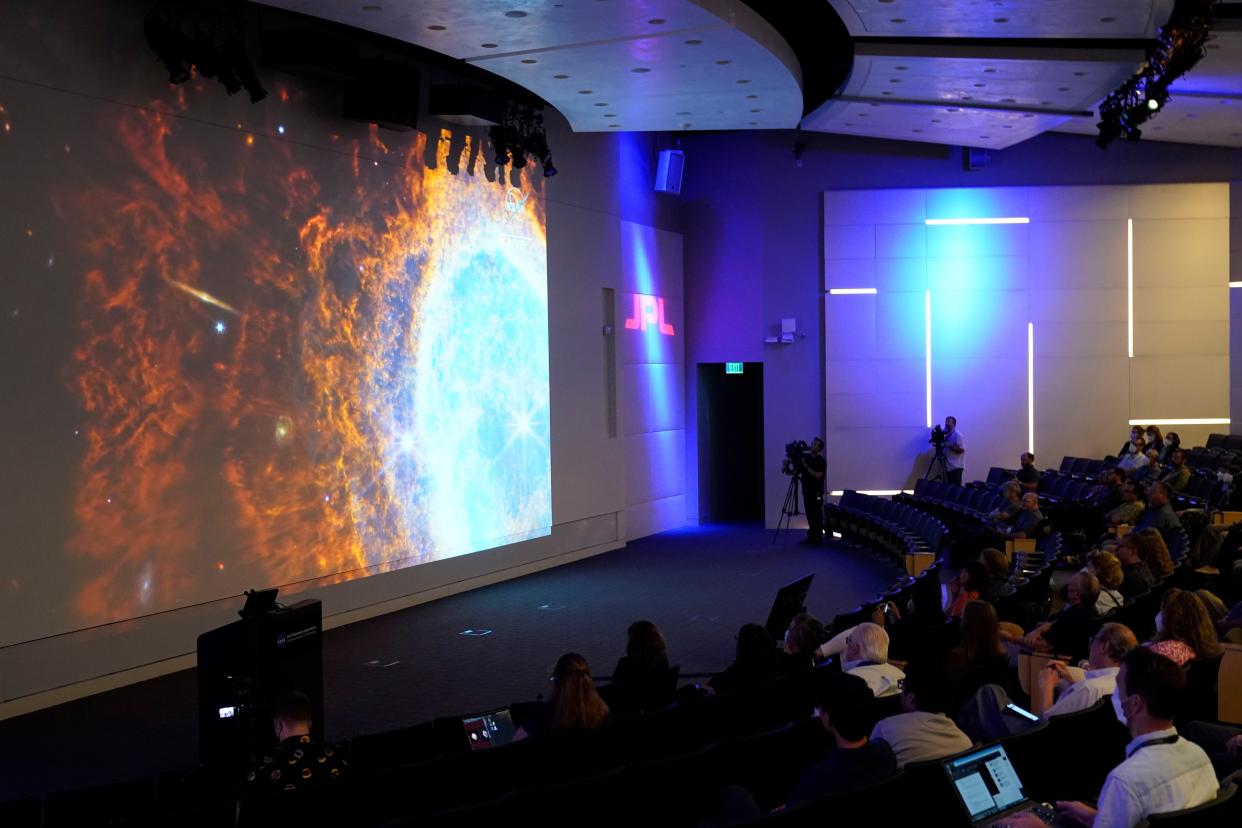SEE IT: NASA releases more new images from James Webb telescope
A day after President Biden revealed the first image from the $10 billion James Webb Space Telescope, NASA released several more stunning images.
The telescope’s first image was of a smattering of distant galaxies and stars which offered the farthest-out view of space ever — an area of space so clustered it glimmers with several marvelous colors.
The image showed “the oldest documented light in the history of the universe from over 13 billion — let me say that again — 13 billion years ago,” Biden said. “It’s hard to fathom.”

This image released by NASA on Tuesday, July 12, 2022, shows the edge of a nearby, young, star-forming region NGC 3324 in the Carina Nebula. Captured in infrared light by the Near-Infrared Camera (NIRCam) on the James Webb Space Telescope, this image reveals previously obscured areas of star birth, according to NASA. (NASA, ESA, CSA, and STScI/)
“It’s an example of what NASA can achieve,” NASA administrator Bill Nelson said Tuesday morning. “It’s one of these great engineering feats— not just for us, but for humanity.”
One of the new images shows the Southern Ring Nebula, a dying star about 2,500 light years from Earth that’s surrounded by a gas cloud that is roughly one light-year in diameter (5.8 trillion miles).
The largest image from Webb shows Stephan’s Quintet, five galaxies bunched together 290 million light-years away. The galaxies pull toward each other, creating swirling, fiery colors.

This image released by NASA on Tuesday, July 12, 2022, combined the capabilities of the James Webb Space Telescope's two cameras to create a never-before-seen view of a star-forming region in the Carina Nebula. Captured in infrared light by the Near-Infrared Camera (NIRCam) and Mid-Infrared Instrument (MIRI), this combined image reveals previously invisible areas of star birth. (Space Telescope Science Institute Office of Public Outreach/)
Finally, the Carina Nebula, 8,500 light-years away, has relatively new stars and large clouds of gases that will eventually become stars.
The last image showed WASP-96b, a gas giant planet about the size of Saturn that’s about 1,150 light-years away.
Astronomers and astrophysicists have anticipated these images since the telescope was launched on Christmas Day 2021. Eventually they hope to capture images from 13.7 billion light-years away which would show what the universe looked like at its infancy.

In this handout photo provided by NASA, NASA's James Webb Space Telescope reveals Stephans Quintet, a visual grouping of five galaxies, in a new light on July 12, 2022 in space. This enormous mosaic is Webb's largest image to date, covering about one-fifth of the Moons diameter. It contains over 150 million pixels and is constructed from almost 1,000 separate image files. (NASA/)
However, it will also be used to search for habitable planets as well provide new data about the formation of black holes and stars and offer images with sharper focus of celestial bodies that have been witnessed before.
“We’ve really changed the understanding of our universe,” said European Space Agency director general Josef Aschbacher.
The telescope was built by NASA and the European and Canadian space agencies. After launching from French Guiana in South America last December, it arrived at its lookout point 1 million miles away in January and began calibrating its instruments and lenses, which are all guarded by a sunshield the size of a tennis court.
“This is absolutely spectacular, absolutely amazing,” University of California, Santa Cruz, astrophysicist Garth Illingworth told the Associated Press. “This is everything we’ve dreamed of in a telescope like this.”

An image of the Southern Ring Nebula, captured on the James Webb Space Telescope, is shown at the NASA Jet Propulsion Laboratory Tuesday, July 12, 2022, in Pasadena, Calif. (AP Photo/Marcio Jose Sanchez) (Marcio Jose Sanchez/)
Webb is seen as the successor to the powerful Hubble Space Telescope which was launched into orbit in 1990. Webb is expected be operational for 20 years.
“It maintains our ability to propel us forward for science, for risk-taking, for inspiration,” NASA administrator Bill Nelson said Tuesday. “We don’t want to ever stop exploring the heavens or stop daring to take another step forward for humanity.”
“‘Somewhere, something incredible is waiting to be known,’” Nelson said, quoting Carl Sagan.
With News Wire Services
